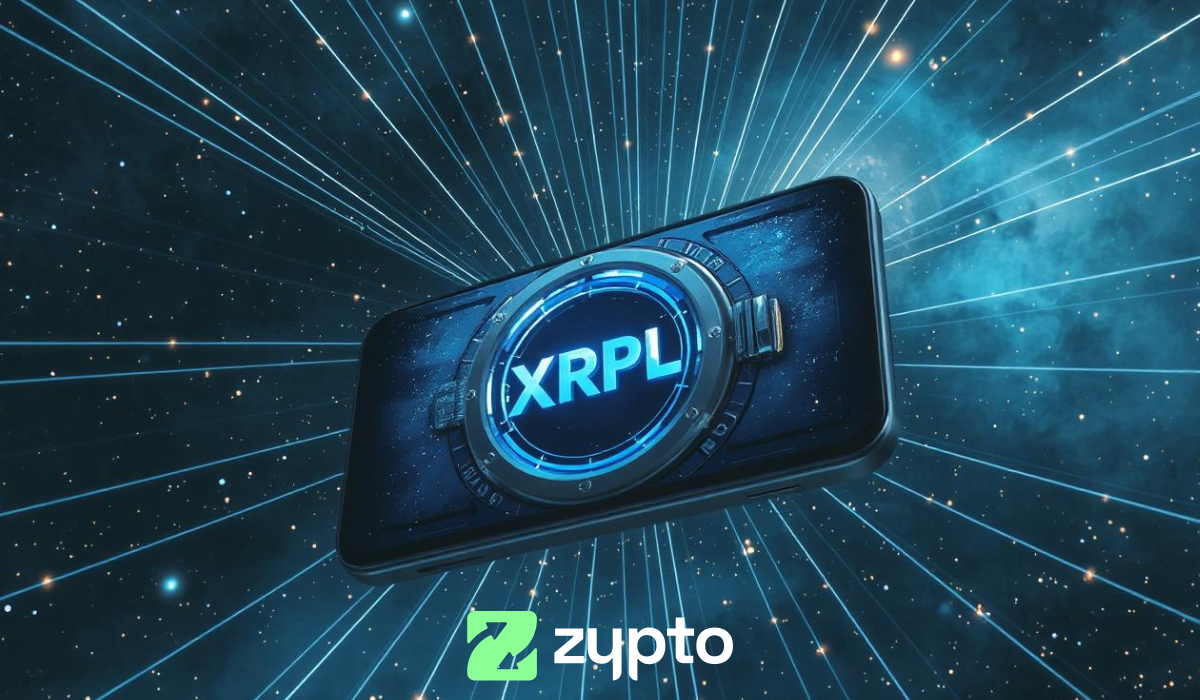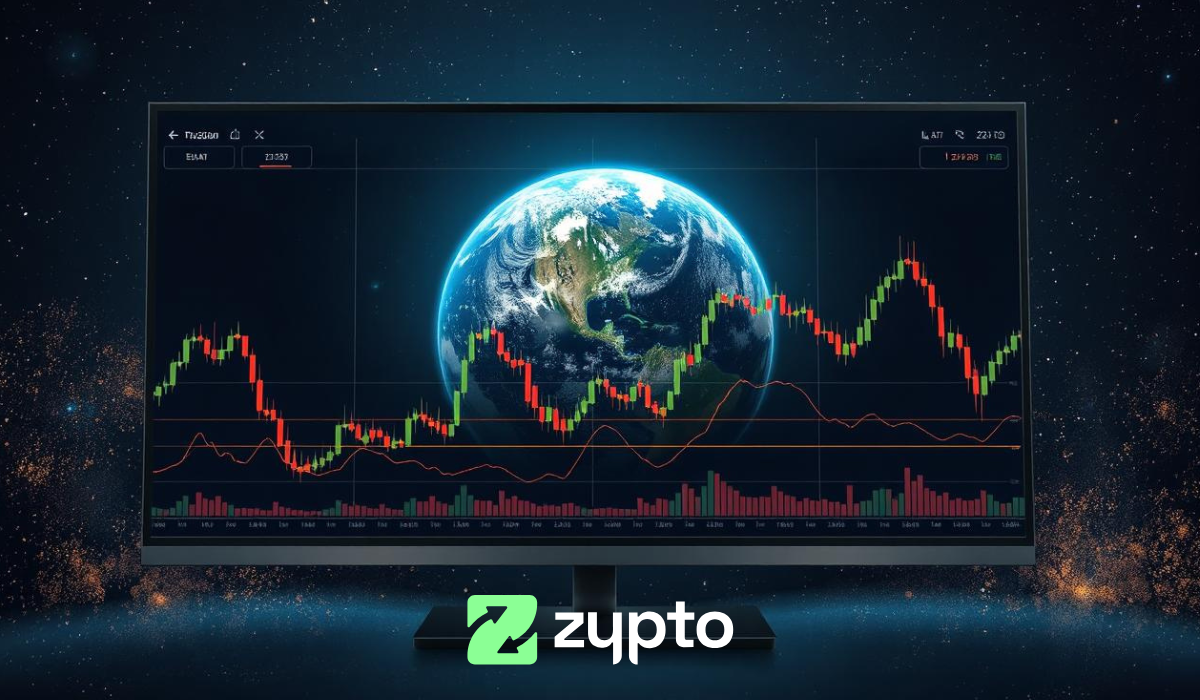Web3 is reshaping the internet into a decentralized, user-powered ecosystem. To participate securely, you need a Web3 wallet – your gateway to managing crypto, NFTs and digital assets.
More than just storage, Web3 wallets let you interact with decentralized apps (DApps), explore DeFi, and unlock new ways to use your digital wealth.
Among the many options, Zypto Wallet stands out as a multi-chain, non-custodial super-app. Supporting thousands of cryptocurrencies, it goes beyond basic storage with integrated DeFi tools, global crypto cards accepted anywhere Visa or Mastercard are accepted, crypto bill pay, mobile top-ups, and advanced cold storage via the Vault Key Card.
In this guide, you’ll learn what Web3 wallets are, how they work, and why Zypto is built to be your all-in-one solution for navigating Web3.
What is a Web3 Wallet?
Just like a physical wallet holds your cash, cards, and ID, a Web3 wallet holds your digital assets. With Web3, it’s practically the same. Web3 wallets are applications made to work with blockchain technology to store digital assets – you can store cryptocurrencies, NFTs, and other blockchain-based valuables.
Stablecoins like USDC may be sent, stored, and received using Web3 wallets. Because of the Web3 infrastructure, these transactions are frequently settled faster and at lower cost than with traditional banking procedures. Additionally, Web3 wallets may be used to safely store Non-Fungible Tokens, which stand for distinctive digital goods like artwork or collectibles.
Web3 wallets can also manage tokenized assets beyond cryptocurrencies and NFTs, such as loyalty rewards or airline miles. This shows how wallets are expanding beyond finance into everyday digital interactions, bridging traditional value systems with the decentralized internet.
Custodial or non-custodial Web3 wallets provide a flexible and safe means of interacting with the blockchain and cryptocurrency ecosystems.

How Does a Web3 Wallet Work?
A Web3 wallet serves as an interface for users to interact with various blockchains and decentralized applications within their ecosystems.
Since Web3 wallets are digital wallets, there is a layer of security known as keys – they serve as passwords or pins, like in a bank card. Each wallet comprises a unique pair of keys. There are two categories of keys including private and public keys.
The wallet’s funds are accessible through the private key, which enables the user to approve transactions; they act like passwords. You wouldn’t want to lose them!
The public key adds another level of protection by encrypting data. Public keys are like your bank account number, it’s sharable as you’ll need it to receive funds. Public keys have a unique address that helps to identify the wallet’s network. Although public keys are like bank account numbers, they are random and alphanumeric.
Using this address, the wallet facilitates the verification of asset ownership and transactions involving cryptocurrencies and NFTs. Through this structure, Web3 wallets enable secure and efficient interaction with the crypto ecosystem, ensuring that users can manage their digital assets with ease.
Features of a Web3 Wallet
Web3 wallets, unlike traditional bank accounts, are designed specifically for the blockchain technology market and offer a unique feature set that empowers users to navigate the decentralized web (DWeb).
Here’s a closer look at some of its key functionalities:
Secure Storage of Digital Assets
This core function allows you to safely store cryptocurrencies, NFTs, and other digital collectibles on a blockchain network.
Web3 wallets leverage cryptography to create a secure environment for your assets, employing techniques like private keys and seed phrases to grant you access and control.
Interaction with DApps
Web3 wallets act as your bridge to the DWeb. They allow you to connect to and interact with decentralized applications (DApps) built on various blockchains.
This opens up a vast range of possibilities, from exploring DeFi (decentralized finance) services like lending and borrowing platforms to engaging with NFT marketplaces or participating in play-to-earn games.
Smart Contract Execution
A key feature of Web3 wallets is their ability to interact with smart contracts. These self-executing contracts automate agreements on the blockchain, eliminating the need for intermediaries.
Web3 wallets can trigger smart contract execution, securely send and receive data relevant to the contract, and verify ownership of assets associated with them.
Support for Multiple Blockchains
Unlike traditional wallets tied to a single platform, many Web3 wallets are interoperable across different blockchains.
This multichain support allows you to manage a diverse portfolio of digital assets existing on various blockchains, providing more flexibility and wider access to the ever-growing DWeb ecosystem.
Built-in DeFi Tools
Some Web3 wallets go beyond simple storage, offering integrated functionalities for DeFi (decentralized finance) activities.
This might include features for swapping cryptocurrencies directly within the wallet, staking your holdings to earn interest on your assets, or participating in DeFi protocols for borrowing and lending digital assets without relying on centralized institutions.
User-Friendly Interface
While security is paramount, usability is also important. Many Web3 wallets prioritize a user-friendly experience with intuitive interfaces that make it easy to manage your digital assets, connect to DApps, and navigate the complexities of the blockchain world.
Even for beginners, user-friendly interfaces can make the transition into the dWeb smoother.
Advanced Security Measures
Since Web3 wallets have custody of your private keys, which grant access to your digital assets, security is a top concern.
Reputable wallets offer robust security features like two-factor authentication (2FA) and secure enclave technology to protect your funds from unauthorized access.
It’s crucial to choose a trustworthy wallet with a strong security track record and maintain proper security practices, such as using strong passwords and keeping your seed phrases confidential, to safeguard your valuable digital assets.

Types of Web3 Wallets
When it comes to Web3 wallets, there are two main categories to consider: custodial and non-custodial wallets. Each offers distinct advantages and caters to different user preferences.
Here’s a breakdown of both wallets and their offerings:
Custodial Wallets
Custodial wallets, managed by third-party service providers like cryptocurrency exchanges, hold your private keys and grant access to your crypto assets. They prioritize user-friendly interfaces and streamline the experience, making them ideal for beginners.
These wallets handle security complexities and often provide recovery options if you lose your login credentials, which can be reassuring for those uneasy about managing private keys.
However, the convenience comes with a trade-off: you lack complete control over your assets. Relying on the service provider’s security measures means you may face limitations on how you can use your funds.
Custodial wallets are best suited for users seeking a simple way to store and manage their crypto holdings, especially those new to Web3 or holding smaller amounts of crypto.
Non-Custodial Wallets
Non-custodial wallets give you full control of your private keys, which are stored locally on your device or a hardware wallet. This eliminates the risk of third-party compromises, enhancing security for your crypto assets.
These wallets offer greater flexibility, allowing you to connect to a wide range of dApps and explore DeFi functionalities. However, with control comes responsibility. You must safeguard your private keys, as losing them could result in permanent loss of access to your assets.
Non-custodial wallets are ideal for experienced users who prioritize security and control. They are also excellent for those who plan to actively engage with dApps and the DeFi ecosystem.

Examples of Web3 Wallets
Here are some examples of popular Web3 wallets across custodial and non-custodial categories:
Zypto Wallet
Zypto is more than just another Web3 wallet, it’s a full crypto super-app. As a non-custodial, multi-chain wallet, it supports thousands of cryptocurrencies, stablecoins, and NFTs across multiple blockchains.
Beyond storage, Zypto empowers users with integrated DeFi tools, including –
- Vault Key Card (VKC) – advanced 3FA cold storage for ultimate offline security
- Integrated DeFi features for multi-chain swaps, staking, and lending
- Global crypto cards accepted anywhere Visa or Mastercard are accepted
- Crypto bill pay and mobile top-ups in over 100 countries
- USDC <> Cash at participating MoneyGram locations worldwide
- Thousands of top-brand gift cards to buy instantly with crypto
Where other wallets focus on one or two features, Zypto brings your entire crypto life together in a single, secure, and user-friendly app.
MetaMask
A leading choice for many, MetaMask offers a user-friendly interface and mobile app, making it easy to navigate the Web3 world. It’s particularly popular for its compatibility with the Ethereum blockchain and a wide range of DApps.
Coinbase Wallet
Integrated with the popular Coinbase cryptocurrency exchange, Coinbase Wallet provides a convenient solution for buying, selling, and storing crypto assets. It prioritizes user-friendliness and caters well to beginners.
Trust Wallet
Designed for mobile devices, Trust Wallet is another user-friendly option with a focus on multiple blockchain support, including Binance Smart Chain (BSC). It’s a popular choice for those interested in DeFi and NFT management.
Rainbow
Rainbow is known for its beautiful and intuitive interface, Rainbow is a non-custodial wallet designed specifically for the Ethereum blockchain. It prioritizes ease of use and security for managing your ETH and ERC-20 tokens.
ZenGo
This non-custodial wallet leverages multi-party computation (MPC) technology to provide enhanced security without compromising on user-friendliness. ZenGo is a good option for those seeking a balance between security and convenience.
Rabby Wallet
A powerful non-custodial wallet for desktop and mobile devices, Rabby Wallet offers advanced features like built-in token swaps and a focus on security. It caters to a more tech-savvy user base.
Phantom Wallet
A popular choice for the Solana blockchain, Phantom Wallet provides a user-friendly experience for managing Solana-based tokens and NFTs. It seamlessly connects to various Solana dApps.
Ledger Live & Trezor Suite
These are hardware wallets, which are essentially secure offline devices that store your private keys. Ledger Live and Trezor Suite offer the highest level of security for your crypto assets but require a separate purchase compared to software wallets.

How to Set Up a Web3 Wallet
General steps for setting up a Web3 wallet (using Zypto Wallet as an example):
Download and Install the App
Head to your app store and search for the Zypto App. Download and install it on your mobile device.
Create a Wallet
Launch Zypto App and begin the wallet creation process. This will likely involve providing a wallet name and any other details necessary.
Seed Phrase Backup
During setup, Zypto App will present you with a seed phrase, which is a series of random words that act as a master key to your wallet.
Write down this seed phrase carefully and store it in a secure location offline. This phrase is crucial for recovering your wallet if you lose your device. Never share your seed phrase with anyone!
Think of it like the master key to your vault – anyone with it can access your assets.
Exploring the App
Once you’ve completed the setup process, you will be able to access the Zypto App’s main interface.
Familiarize yourself with the layout and functionalities offered by the app. This includes options to:
- Buy and sell cryptocurrencies directly within the Zypto App
- Send and receive cryptocurrencies to other Zypto users or external wallets
- View your current crypto holdings and transaction history
- Access integrated DeFi features
Conclusion
Web3 wallets are essential tools for exploring the decentralized internet. They give you control over your crypto, access to DApps, and new ways to interact with digital assets. Whether you’re just starting or managing a complex portfolio, there’s a Web3 wallet that fits your needs.
For users who want more than basic storage, Zypto Wallet delivers the most complete Web3 experience, from multi-chain asset management to DeFi, payments, and secure cold storage with the Vault Key Card.
Download Zypto App today – your all-in-one Web3 wallet for storing, spending, and securing crypto.
Securely Manage Your Digital Assets with Zypto
Zypto empowers users to securely manage digital assets in Web3 with their user-friendly Zypto Wallet. This simplifies crypto storage and interaction, making Web3 participation a breeze.
We’d love to hear your thoughts on Web3 wallets – what excites you most about the future of DeFi? Share your questions or predictions in the comments below.

FAQs
What is a Web3 wallet?
A Web3 wallet is a digital tool that lets you store cryptocurrencies, NFTs, and other blockchain assets, while also connecting to decentralized apps (DApps).
How does a Web3 wallet work?
It uses cryptographic key pairs – your private key to authorize transactions and your public key to receive funds and verify ownership.
What is the difference between custodial and non-custodial Web3 wallets?
Custodial wallets are managed by third parties and store your keys for you, while non-custodial wallets like Zypto let you control your own private keys.
What is the best Web3 wallet?
The best Web3 wallet depends on your needs. For multi-chain support, thousands of assets, DeFi tools, and secure cold storage, Zypto Wallet offers one of the most complete solutions.
Can I use a Web3 wallet for NFTs?
Yes. Web3 wallets allow you to securely store, send, and receive NFTs alongside cryptocurrencies and other tokenized assets.






















0 Comments